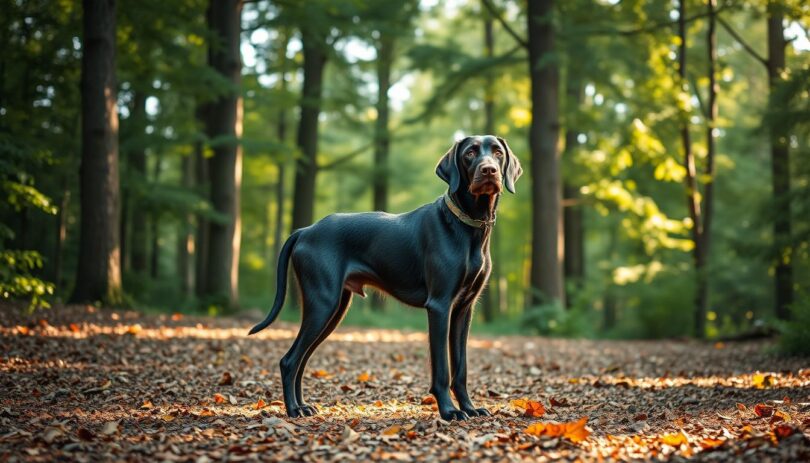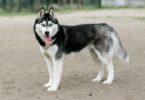Welcome to our comprehensive guide to the German Wirehaired Pointer, a breed that seamlessly blends versatility with affection. Whether you’re an avid hunter or a devoted pet owner, this medium-to-large dog is sure to capture your heart with its unique charm and robust build.
Originating in 19th century Germany, the German Wirehaired Pointer was meticulously bred to excel as a hunting companion. Developed from crosses with the Wirehaired Pointing Griffon and Pudelpointer, this breed boasts a weather-resistant wiry coat and a physique designed to thrive in challenging environments.
In this guide, we’ll delve into the history, physical traits, temperament, and expert care tips for your German Wirehaired Pointer. Recognized by major kennel clubs such as the VDH and the Fédération Cynologique Internationale, this breed is celebrated for its loyalty, intelligence, and exceptional hunting prowess.
Discover how to maintain their distinctive coat and ensure their overall health with our science-backed advice. Whether you’re seeking to enhance their hunting skills or simply provide a loving home, this guide is your go-to resource for everything German Wirehaired Pointer.
History and Origins of the Breed
In the late 19th century, Germany saw the emergence of a remarkable hunting companion—the German Wirehaired Pointer. Developed in the 1880s, this breed was crafted to excel in versatile hunting roles, blending strength with agility.
19th Century Beginnings in Germany
The journey began when breeders sought a dog adept at both upland game and waterfowl retrieval. By crossing the Wirehaired Pointing Griffon and the Pudelpointer, they achieved a robust, weather-resistant coat and a physique built for endurance.
Breeding Influences and Development
Baron Sigismund von Zedlitz und Neukirch led these efforts, establishing rigorous tests to ensure each dog’s prowess in the field. These tests weren’t just physical; they assessed the dog’s nose, water affinity, and retrieving skills, setting a high standard for the breed.
Today, kennel clubs like the VDH and FCI recognize the German Wirehaired Pointer, celebrating its loyalty and intelligence. Its historical role as a versatile hunter still shines through, making it a prized companion both in the field and at home.
Distinctive Physical Traits and Coat Care
The German Wirehaired Pointer is a medium to large dog with a well-muscled, balanced build that reflects its heritage as a versatile hunting companion. One of its most striking features is its weather-resistant, wire-like coat, which provides excellent protection in heavy cover and cold water.
Appearance, Build, and Unique Features
Standing between 22–26 inches tall and weighing 50–70 pounds, this breed has a robust yet agile physique. The coat, typically 1–2 inches long, features a dense undercoat that adapts to seasonal changes—thicker in winter and lighter in summer. Facial furnishings, including eyebrows, beard, and whiskers, add to its distinctive look, while the docked tail complements its balanced appearance.
Maintaining the Wiry, Weather-Resistant Coat
To preserve the coat’s wiry texture, periodic stripping is necessary. Using specialized shampoos during baths helps maintain both the coat’s functionality and aesthetic appeal. Regular grooming ensures the coat remains weather-resistant and continues to protect the dog in various environments.
German Wirehaired Pointer Temperament and Activity Needs
The German Wirehaired Pointer is a loyal and intelligent breed, excelling both as a family companion and a skilled hunting dog. Their high energy levels and strong prey drive make them ideal for active families who enjoy outdoor activities.
Family Companion with Versatile Hunting Instincts
At home, this breed is affectionate and gentle, forming strong bonds with their family. They are naturally protective but not aggressive, making them great with children. Their hunting instincts shine during family hikes or playtime, showcasing their agility and endurance.
With a high prey drive, they thrive in environments where they can engage their instincts, whether chasing game or playing fetch. This dual nature makes them a perfect fit for families who love the outdoors and can provide the necessary stimulation.
Daily Exercise and Mental Stimulation Requirements
Given their high energy, these dogs need ample daily exercise and mental challenges. Interactive play, obedience training, and scent work are excellent ways to keep them engaged and happy. Positive reinforcement and consistent training methods are key to their development.
They require at least 1-2 hours of exercise daily, including long walks, hikes, and play sessions. Without sufficient activity, they may develop boredom-related behaviors. Providing a clear purpose, whether through work or play, keeps them fulfilled and content.
A strong bond with their person is essential for their well-being. Engaging in activities together strengthens this bond and ensures they remain happy and healthy.
Expert Care Tips for German Wirehaired Pointer
Providing the right care for your German Wirehaired Pointer ensures they lead a healthy, active life. Whether they’re a puppy or an adult, understanding their needs is key to their well-being.
Nutritional Guidelines and Feeding Tips
Feeding a high-quality diet is essential. Choose food that meets AAFCO standards to ensure it’s nutritionally balanced. Puppies need 3-4 meals daily, while adults require two meals. Portion control is important to maintain a healthy weight.
As they grow, their dietary needs change. Adults thrive on a balanced diet rich in protein and fats for energy. Consulting a vet can help tailor their diet to their specific needs.
Managing Health Conditions and Preventative Care
Von Willebrand Disease and hypothyroidism are common health issues. Regular blood tests can detect these early. Hip and elbow dysplasia are also concerns, manageable with proper veterinary care.
Preventive care includes regular vaccinations and check-ups. Ear cleaning should be done monthly, and annual eye exams are recommended. A healthy diet and regular exercise contribute to a long lifespan of 14-16 years.
Attentive care strengthens the bond with your pet. With the right approach, your German Wirehaired Pointer can enjoy a fulfilling, healthy life by your side.
Training, Socialization, and Outdoor Adventures
Training and socializing your German Wirehaired Pointer is crucial for harnessing their energy and instincts. Early training helps manage their strong independent nature and hunting drive, ensuring they grow into well-rounded companions.
Positive Reinforcement and Consistent Training Techniques
Positive reinforcement is key to shaping desired behaviors. Reward good actions with treats and praise to encourage positivity. Consistency in training helps your dog understand expectations, making them more responsive and obedient.
Engaging in Hunting, Agility, and Outdoor Activities
Outdoor activities like hiking, fetch, and nose work keep your dog engaged. Specialized training, such as duck retrieval, channels their natural drive. Balance structured training with free play to maintain mental and physical health.
Bringing It All Together for Lifelong Happiness
Caring for a German Wirehaired Pointer is a rewarding journey that requires attention to their physical and emotional needs. By understanding their history, maintaining their robust build, and providing proper training, you can ensure a fulfilling life for your pet. This breed thrives on balance—whether it’s between work and play or home life and outdoor adventures.
Regular veterinary check-ups, consistent exercise, and tailored nutrition are the foundation of a healthy, active lifestyle. As your dog grows from a curious pup into a skilled companion, adapt care routines to meet their evolving needs. With the right approach, your German Wirehaired Pointer will be a loyal, energetic partner for many years.
Empowered with expert knowledge, you can create a nurturing environment where your dog flourishes. From forest treks to cozy evenings at home, this versatile breed will bring joy and companionship. Dive deeper into their care with resources like Golden Retriever care tips for a well-rounded approach. Together, you and your German Wirehaired Pointer can enjoy countless adventures and shared happiness.
FAQ
What makes the German Wirehaired Pointer a versatile hunting dog?
The breed’s strong prey drive, water-resistant coat, and adaptability to both field and water make it an excellent choice for hunters seeking a versatile hunting companion.
How much exercise does a German Wirehaired Pointer need daily?
This high-energy breed requires at least 1-2 hours of vigorous exercise daily, including running, swimming, and playtime, to stay physically and mentally stimulated.
Are German Wirehaired Pointers good family pets?
Yes, they make loving family pets for active households. They are loyal and affectionate but need consistent training and plenty of exercise to thrive.










Leave a Comment